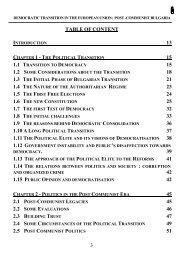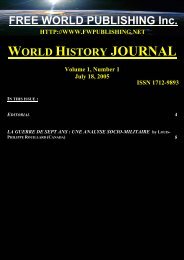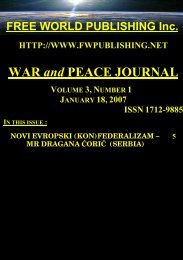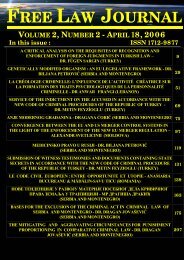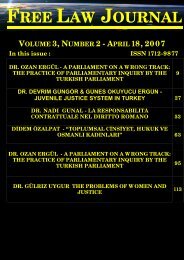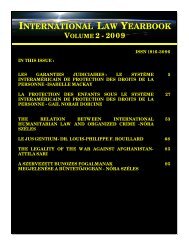Free_Law_Journal-Vol.. - Free World Publishing Inc.
Free_Law_Journal-Vol.. - Free World Publishing Inc.
Free_Law_Journal-Vol.. - Free World Publishing Inc.
Create successful ePaper yourself
Turn your PDF publications into a flip-book with our unique Google optimized e-Paper software.
FREE LAW JOURNAL - VOLUME 1, NUMBER 1 (18 JULY 2005)<br />
But, not every kind of danger for these legal properties is relevant according to the institute of extreme<br />
necessity. It has to be the danger which has a character of social danger, and it has to be such danger<br />
which imminently endangers some legally protected property. This danger can be aimed against legal<br />
property of that person who eliminates such danger by his action, or against legal property of some other<br />
physical or legal person. In this second case, there is necessary help.<br />
3) Danger has to be simultaneous. This means that danger is imminent, or already in progress, and only up<br />
to the point when danger is still in progress. Future, as well as finished danger, does not give the right for<br />
action in extreme necessity. It would be unacceptable if perpetrator, during the flood or fire, waited for<br />
some legal property to be destroyed, and then took measures for eliminating danger. Because in that case,<br />
these measures would obviously be late. According to this, depending on the kind, character, source and<br />
level of danger, perpetrator has the right to undertake some measures in order to eliminate danger which<br />
has already taken place and which will obviously soon endanger some of his legal property.<br />
But, in the theory of criminal law 10 , such opinions could be found, according to which extreme necessity<br />
is allowed, if it is obvious that in several days there would be a hurricane or that the flood would break<br />
levees and destroy a settlement, because it is considered that there is imminent danger of that. In<br />
conditions when very complicated technical and technological systems and procedures are used, such<br />
situations, according to which it is obvious that there would be some great harm, can also take place.<br />
4) Danger has to be real. It should really exist in the real world-it should already be in progress or it<br />
should be imminent. Danger is real not only when there is a realised possibility of violation or<br />
endangering, when violation or endangering are already in effect, but also when it is imminent. This<br />
means that it is objectively and with certainty assumed that the danger for one’s legal property is<br />
imminent.<br />
Imaginary, illusory danger does not give the right for action in extreme necessity. In that case there is so<br />
called putative necessary defence. Namely, those are the situations when there is wrong or incomplete<br />
conscious or knowledge about the circumstances which really existed and which would possibly justify<br />
the action of perpetrator in extreme necessity. Then the perpetrator can only quote that he made a mistake<br />
about the existence of danger, which represents a factual basis for mitigating the sentence, but there is no<br />
extreme necessity. Therefore, not every danger is relevant according to the point of view of the institute of<br />
extreme necessity. It has to be danger of certain level and certain gravity. It results that not any, especially<br />
not an insignificant violation of legal property, can represent basis for the existence of this institute 11 .<br />
5) Danger must not be blameable. Danger is not blameable if it occurred by accident and if a person in<br />
danger is not to be blamed for it. If a person deliberately, or out of negligence, provokes danger for legal<br />
property, that person cannot quote action in the state of extreme necessity, in case when eliminating such<br />
danger he violates someone else’s legal property. This means that in case of blameable provoking danger<br />
there is no extreme necessity, so that the person should be responsible for the criminal act committed<br />
during eliminating danger. S. Zuglia 12 considers that the fact that the endangered person anticipated or<br />
could anticipate that he could save himself or his legal property only by violation of someone else’s legal<br />
property, is obviously not enough for blaming it.<br />
10 Miloš Babić, Krajnja nužda u krivičnom pravu, Banja Luka, 1987.p.95<br />
11 Dragan Jovašević, Tarik Hašimbegović, Osnovi isključenja krivičnog dela, Institut za kriminološka i sociološka istražianja,<br />
Beograd, 2001. p. 125<br />
12 Srećko Zuglia, Stanje nužde, Veliki Bečkerek, 1920.p.45<br />
111<br />
DR. DRAGAN JOVAŠEVIĆ - THE EXTREME NECESSITY IN CRIMINAL LAW OF SERBIA AND<br />
MONTENEGRO






